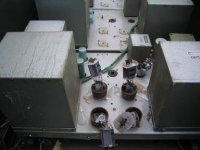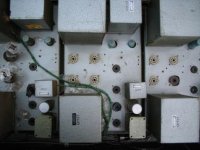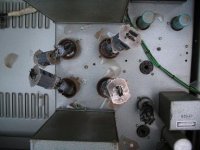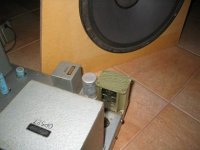Help please,
I have inherited 3 large cinema amps, they use 4x kt66 per channel.
If any one can help me identify the output trafos it will help me a lot. The trafos are made by ferguson and have the number OP527 on them. What i need is the connection diagram for the taps. At the moment they are set for 100volt output.
The amps were made by National in 1970, possibly in Sydney.
Photos to follow.
I have inherited 3 large cinema amps, they use 4x kt66 per channel.
If any one can help me identify the output trafos it will help me a lot. The trafos are made by ferguson and have the number OP527 on them. What i need is the connection diagram for the taps. At the moment they are set for 100volt output.
The amps were made by National in 1970, possibly in Sydney.
Photos to follow.
Hi
You could try their new owners.
They may have some archival information.
http://www.telectran.com/ferguson.php
Good luck
Rob
You could try their new owners.
They may have some archival information.
http://www.telectran.com/ferguson.php
Good luck
Rob
All I could dig up was this data on Ferguson Transformers' "medium fidelity" range, which clearly isn't what these cinema amps have.
http://www.retrovox.com.au/ferguson.pdf
A shame about the KT66s... The sight of those smashed valves breaks my heart
You could probably determine most of the leadouts of the transformers by having a look at how they're hooked up in the amp right now. The impedance ratio can be determined from the square of the turns raio - which can be found by applying a known AC voltage to the primary, and measuring the resultant voltage on the secondary (or vice versa).
http://www.retrovox.com.au/ferguson.pdf
A shame about the KT66s... The sight of those smashed valves breaks my heart

You could probably determine most of the leadouts of the transformers by having a look at how they're hooked up in the amp right now. The impedance ratio can be determined from the square of the turns raio - which can be found by applying a known AC voltage to the primary, and measuring the resultant voltage on the secondary (or vice versa).
exurbia said:the owner had just had the amps serviced
Oh. So then they should probably be working once they get new valves, yeah?
exurbia said:I managed to find four brand new ones in boxes that had not been smashed. These are now for sale as i have no use for them.
Not going to use them in one of the cinema amps?
btw, how much?
The kt's are of no use to me as finding another eight is too hard. My son wants to re valve using either 6l6 or 807 as they are easy to source. According to my Rider master handbook the 6l6 will sub with no adjustments. Is this correct ? I want to have a listen before i sell the amps or swap them. Personally i find the size and weight of these amps to be inconvenient. They weigh about 40 kilos each. A friend up here has suggested using two 4-125a's in pp per amp rather than a quad of kt66 etc. The power trafos are really big and have 2 secondarys one of 600 0 600, 260 0 260 a 50v bias tap and a very big 6.3 volt supply at least 12 amps according to what was being run, including the pre amp supply. Unfortunately the cabinet was damaged beyond repair, although i'm sure my other half wouldn't have let me keep it. Each amp has a balancing trafo for input and the pre is also balanced.
exurbia said:The kt's are of no use to me as finding another eight is too hard. My son wants to re valve using either 6l6 or 807 as they are easy to source. According to my Rider master handbook the 6l6 will sub with no adjustments. Is this correct ? I want to have a listen before i sell the amps or swap them. Personally i find the size and weight of these amps to be inconvenient. They weigh about 40 kilos each. A friend up here has suggested using two 4-125a's in pp per amp rather than a quad of kt66 etc. The power trafos are really big and have 2 secondarys one of 600 0 600, 260 0 260 a 50v bias tap and a very big 6.3 volt supply at least 12 amps according to what was being run, including the pre amp supply. Unfortunately the cabinet was damaged beyond repair, although i'm sure my other half wouldn't have let me keep it. Each amp has a balancing trafo for input and the pre is also balanced.
4-125s?
way = no.
The 4-125s require a much higher plate voltage and higher plate Z.
Also, the output tranny's configuration needs to be determined. Separate primaries per pair of tubes? Paralled tubes? Big diff in primary Z.
The 807s only make sense if there is excess plate voltage available/present. They also need a different socket and plate caps added.
Consider, depending on ouput tranny config & Z, plate voltage any of the present day tubes; 6CA7/EL34, 6L6GC, 6550, KT88 etc...
Rewiring a tube socket isn't a big deal.
Depending on the rest of the amps performance, consider strapping the tubes for triode operation. Generally speaking strapped for triode sounds "smoother" than the same amp run in pentode or UL... you lose a little power, but with 4 tubes you may not need an extra dB.
Certainly determine if it is a fixed screen bias or UL style set up for the output tubes.
You'll want to take a look at the performance of the output tranny. Probably it is a good idea to remove or reduce the effect of the cap that is doubtless across the feedback resistor. The cap is generally there to pull up the HF response. It usually causes HF ringing, visible on a square wave. Imho, it tends to sound nasty compared to the same amp without that ringing.
Back in the day, mfrs wanted to boast "20-20kHz" response so it was common to use the feedback loop to compensate for less than stellar HF response from the output iron. If ur amp is flat out to ~10kHz. or higher, you can usually do just fine by eliminating the cap. At least take the time to remove the cap from the circuit and see what the amp's response looks like without it...
If the amp is xfmr coupled to the ouput stage, its potential might be seen as greater than if RC coupled.
My thought is that if the HF response without the cap is poor and the LF response isn't particularly great either (not enough inductance in the the output iron) then fix it up and move on... If you need a decent tube bass/midbass amp and the LF is good, then it might be work keeping around for that...
_-_-bear

KT66 is pretty much equal to a good 6L6GC. Sovteks and many others won't cut it. Electroharmonix will cut it. If you can find 7581A's you will have a great sub. In North America these are frequently branded as 7581A/KT66. I've used these and they are wonderful. Try good 6L6GC's first.
Bear, heater current. 6CA7 and EL34 draw a fair bit more that KT66. At least in my manuals they do. The difference X 4 is a bit much.
-Chris
Bear, heater current. 6CA7 and EL34 draw a fair bit more that KT66. At least in my manuals they do. The difference X 4 is a bit much.
-Chris
anatech said:KT66 is pretty much equal to a good 6L6GC. Sovteks and many others won't cut it. Electroharmonix will cut it. If you can find 7581A's you will have a great sub. In North America these are frequently branded as 7581A/KT66. I've used these and they are wonderful. Try good 6L6GC's first.
Bear, heater current. 6CA7 and EL34 draw a fair bit more that KT66. At least in my manuals they do. The difference X 4 is a bit much.
-Chris
Ah yess the heaters... well ya gotta look at what the transformers say they can handle... if need be it might be possible to run a small second heater xfmr under the chassis or on top to run one of the pairs... being indirectly heated, it is very unlikely to cause any issues.
_-_-bear

Those smashed KT66s make me feel rather ill !
Luckily I found my cinema amps before the vandals had a crack at them.
Also uses pp parallel KT's
Luckily I found my cinema amps before the vandals had a crack at them.
An externally hosted image should be here but it was not working when we last tested it.
Also uses pp parallel KT's
Why not just re-tube with KT66? You can buy cheap russian and chinese ones that are supposed to be very good indeed, and they are not much more expensive. If the amplifier is well designed they won't be too stressed and should last a long time.
KT66 is the hi-fi version of a 6L6GC, made with different grid and anode spacing specifically for audio.
You should be able to simply plug and play with any of the 6L6GC variants out there, without any change in the circuit and it will still work fine.807s are the same as well, but you will need to change sockets and also check the dissipation isn't excessive.
However KT66 look much cooler...
:edit: whoa! Crazy big cinema amp / room heater you got there! Where's that from then?
KT66 is the hi-fi version of a 6L6GC, made with different grid and anode spacing specifically for audio.
You should be able to simply plug and play with any of the 6L6GC variants out there, without any change in the circuit and it will still work fine.807s are the same as well, but you will need to change sockets and also check the dissipation isn't excessive.
However KT66 look much cooler...
:edit: whoa! Crazy big cinema amp / room heater you got there! Where's that from then?
Don't wreck 'em!
Those amplifiers look well worth reviving. The size of the transformers compared to the valves suggests that they are of decent quality (oh, and the weight you complained about is also a good sign). The question is more whether the driver department is up to the job. As for getting eight more KT66, NOS GEC KT66 are available, they're just rather pricy (typically £70 each). Of course, you might feel that you don't need all three amplifiers to be working at any one time, in which case you only need four more KT66.
A photograph of the insides would be very useful, as would any indications as to what the other valves are/were.
Those amplifiers look well worth reviving. The size of the transformers compared to the valves suggests that they are of decent quality (oh, and the weight you complained about is also a good sign). The question is more whether the driver department is up to the job. As for getting eight more KT66, NOS GEC KT66 are available, they're just rather pricy (typically £70 each). Of course, you might feel that you don't need all three amplifiers to be working at any one time, in which case you only need four more KT66.
A photograph of the insides would be very useful, as would any indications as to what the other valves are/were.
- Status
- This old topic is closed. If you want to reopen this topic, contact a moderator using the "Report Post" button.
- Home
- Amplifiers
- Tubes / Valves
- cinema amps




